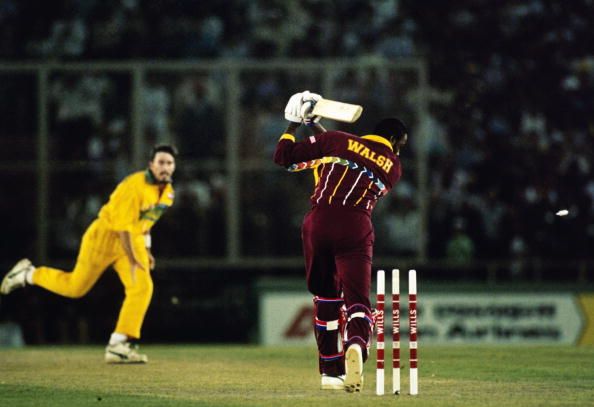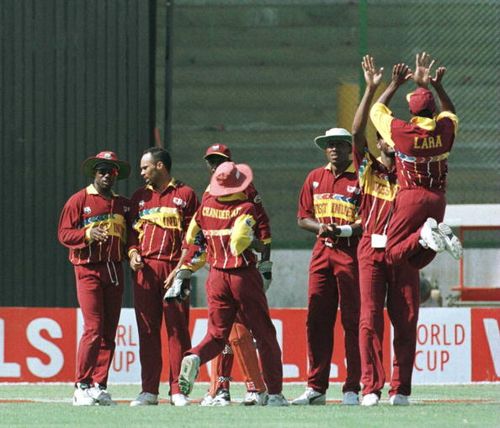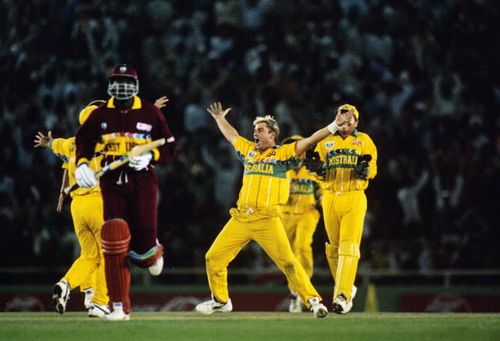
When Australia pulled off a thrilling victory in the World Cup semifinal

14th of March 1996. The stage was set for a high voltage clash between Australia and West Indies in the World Cup semifinal at Mohali. The entire city was buzzing with excitement. The cricket fans thronged the stadium in huge numbers, braving the heavy traffic, the horn-honking and the scorching sun. Amazingly, a few days back, the hosts India had been sent packing by a buoyant and exuberant Sri Lankan outfit, in the other semifinal. But that hadn’t dampened the spirits of cricket fans across India. The sizzle of anticipation and the electrifying atmosphere in the stadium just exemplified the extraordinary passion of India’s cricket loving public.
Backdrop
Going into the 1996 World Cup, West Indies cricket was in shambles. The once all-conquering mighty Windies team seemed to have lost its carnassial edge. The sharp claws were weak, and eyesight not good enough to hunt down opponents. The West Indies cricket team just looked a pale shadow of its former self. On their ill-fated tour to Australia in 95/96, they had to endure a host of embarrassing experiences, including not reaching the final of the tri-series Down Under. In-fighting and bitterness seemed to be rampant in the West Indies camp. It is even said that during the 95/96 World Cup, Lara and the then captain Richie Richardson didn’t see eye to eye.
On the other side of the spectrum, Australia had gone from strength to strength. After sending shock-waves through the cricketing world by upsetting the apple-cart and defeating the Windies in their own den, they had quelled the challenge of both Pakistan and Sri Lanka at home. They had also won the Benson and Hedges tri-series in 95/96. Those days, Australia winning the annual tri-series held Down Under was almost a foregone conclusion.
Folks, it is time now for some lights, camera and action, as we rewind back in time to look back at the edge-of-the-seat thriller played between West Indies and Australia at Mohali.
Australia won the toss and elected to bat first
Australia won the toss and rather surprisingly elected to bat first. The track at Mohali had a bit of juice in it, and there was ample pace and bounce on offer too. With the troika of Ambrose, Bishop and Walsh in their ranks, the Windies had the arsenal to unnerve the famed Australian top-order on a pacy wicket.
The defeat at the hands of minnows Kenya seemed to have woken up Ambrose, the emperor of mass destruction. He had bowled a hostile and mean spell against the South Africans in the quarterfinal. In the semifinal, the bloodthirsty Ambrose had ran amok, and bowled with fire and brimstone to terrorize the Australians.
Having already made three sublime hundreds, Mark Waugh, the Mozart of the willow, was in supreme touch. Even when opposition captains set ring fields to frustrate Mark Waugh into doing something silly, he was caressing the ball into gaps. In the semifinal though, it took a mere two deliveries for Ambrose to send Waugh back into the pavilion. The first delivery nipped back sharply into Waugh, who left it alone. Ambrose followed it up with another one that nipped back, but this time around, it was bang on the money as it trapped Waugh dead in front.
All of a sudden, the Australians were in uncharted territory. Since Mark Waugh had taken over from Slater as an opener in the 95/96 WSC, the Aussies were used to rollicking starts given by Waugh. His dismissal made the Australians press the panic button, as they were soon reeling at 15 for 4. Bishop detonated the stumps of Taylor and the elder Waugh. Both played poor shots, as they inside-edged good length deliveries onto the stumps. The young prodigy, Ponting, was taken care of by one that nipped back, from Ambrose. For once, the pre-tournament favourites didn’t seem to have a plan B in the bank.

Stuart Law and Bevan rebuild the innings.
All those early wickets brought Law and Bevan to the crease. As Mark Waugh was in supreme touch in the World Cup, the relatively inexperienced pair of Bevan and Law hardly got a chance to bat. At 15 for 4 though, both Bevan and Law were thrust into the limelight. For both men, it turned out to be a war of attrition when up against Ambrose.
Finally, Stuart Law tried to break the shackles with a pristine drive down the ground of Ambrose. It was a near perfect back of a length delivery on top of off-stump from Ambrose. But Law had the chutzpah to come onto the front-foot, ride on top of the bounce and essay an off-drive back past a stunned Ambrose for a boundary. It must have brought some cheers in the gloomy Australian dressing room.
At the other end, the wily fox, Bevan, was waiting to take advantage of lesser bowlers like Gibson, Adams and Harper. His wish was granted, as Gibson was introduced into the attack. As soon as Gibson bowled a short and wide delivery, Bevan pounced on it with a rapier-like cut shot in the 18th over of the match. Bevan also peppered the covers and extra cover-regions constantly. His partner in crime, Law, smothered the spinners on the front-foot with nimble footwork, and waited for them to bowl short. When the seamers were bowling, he played them in the V.
By covering the length and the breadth of the pitch like jackrabbits, Law and Bevan kept the scoreboard ticking. Eventually, it took a terrible mix-up between Law and Bevan to break the partnership as Law was run-out for a sparkling 72 in trying circumstances. In a bid to accelerate the scoring rate, Bevan too perished in the 45th over of the match for a well-measured 69. West Indies must have been already sick of watching Bevan’s houdini acts, as a few months back he had taken Australia from the jaws of defeat to a nerve-wracking win, in a one-day game at SCG.
Ian Healy’s cheeky innings of 31 meant that Australia made 207 in their allotted fifty overs. At 15 for 4, the Australian captain, Mark Taylor, would have taken that score. But there was a feeling that a total of 207 was 30-40 runs short of a winning score.
West Indies chase
In an attempt to ape the revolutionary Sri Lankans, the West Indies team opened their batting with the pinch-hitter, Courtney Browne. It forced the shrewd Taylor into introducing his trump card and sheikh of tweak, Warne, into the attack in the 6th over of the innings. The shrewd move paid rich dividends as Browne tried to smash a shortish delivery, but only succeeded in giving a return catch to Warne.
Despite losing Browne’s wicket early in the innings, Chanderpaul and the prince of Trinidad, Brian Lara, took West Indies to a strong position. Lara played a few majestic drives which sent the delirious crowd into a tizzy. The trademark arc of Lara’s extravagant back-lift was a sight to behold. It took a peach of a delivery from Steve Waugh to castle Lara for a run-a-ball 45.
Wearing a maroon floppy hat and sporting none of the accoutrements that modern day batsmen wear, the captain, Richie Richardson, joined Chanderpaul in the middle. The ebullient Richardson was coming to the end of his illustrious career. He certainly wanted to end his career on a high note with a World Cup triumph. The doggedly determined Richardson, along with the calm, cool and collected Chanderpaul, took West Indies to the cusp of a famous victory. With 10 overs to go, the Windies needed a shade under 50 runs to win the match.

Taylor’s shrewd captaincy and Warne’s intoxicating brilliance
When everyone thought the West Indian batsmen were in cruise mode, Chanderpaul lost his concentration and gifted his wicket away. Australia’s captain Mark Taylor brought his fielders inside the circle, and baited Chanderpaul into taking the risk of playing lofted shots against McGrath. Chanderpaul, struggling with fitness, duly obliged by spooning a catch to the mid-on fielder. Mark Taylor’s gut feeling had worked for Australia.
With seven wickets left in the shed, West Indies were still ahead in the game. It made Taylor go for the jugular, as he gave the ball to the wizard of Oz, Shane Warne. It was basically the last throw of the dice by Taylor. Warne, with his bagful of tricks, culled the Windies with an enchanting spell of 3 for 6 in 3 overs. The Windies batsmen have to be blamed as they kept playing across the line against Warne’s deadly flippers. The worst offender was Arthurton, as he tried to play an agricultural hoick across the line and threw his wicket away.
The last two overs
With the Windies batsmen falling like nine pins, the captain Richardson cut a forlorn figure. Richardson didn’t give up though, as he played a savage pull off Fleming to bring the equation down to 14 runs of 2 overs. The capacity crowd was on the edge of their seats, and a few started biting their nails. It was a cauldron of bubbling tension at the Mohali stadium.
In the last over of the match, Richie Richardson used his pyrotechnics to smash Fleming over the mid-wicket region for a boundary. But there was another twist in the tale, as on the next ball, Ambrose went for an ill-judged single, and got himself run-out. It was hard to fathom why Ambrose so desperately wanted to take that single, as Richardson was the senior partner. The swing king, Fleming, hammered the final nail in the coffin by uprooting the stumps of Walsh with a good length delivery, and Australia won by 5 runs. The ecstatic Australians had just snatched a victory from the jaws of defeat.
It was a sad sight to see the West Indian captain, Richardson, trudge back to the pavilion. The talismanic captain was left stranded by some farcical dismissals. Unfortunately for Richardson, that game against Australia turned out to be his last international match. Predictably, the win triggered frenzied and wild celebrations from the Australians. On that pleasant night, the Aussies celebrated like there was no tomorrow.